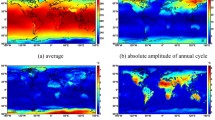Abstract
We have derived a global zenith tropospheric delay simplified model (GZTDS), assuming that the troposphere is a nonlinear system and can be handled as a black box. The GZTDS and its variation in time can be expressed as a series of cosine components, which represent various periods of tropospheric delay changes. Undetermined coefficients are extracted by data fitting from the mean sea level historical data of the global geodetic observing system atmosphere on a 2° × 2.5° grid. A combination of our model and the Vienna Mapping Function 1 can predict slant delays for global navigation satellite system sites using the zenith angle and nearest grid coordinates as the input and generate a global slant tropospheric delay simplified model (GSTDS) and its extension. Comparisons with the zenith delays provided by the International GNSS Service at 358 sites show that the biases are between −3.36 and 2.41 cm, and the mean standard deviation is 3.46 cm for the year 2014. This result is at the same level of accuracy as the global pressure and temperature 2 wet model (GPT2w), with the GZTDS requiring no local meteorological parameters. The accuracy of GSTDS depends on the zenith angle and shows nonlinear characteristics. Several statistics of biases and standard deviations illustrate model adaptation with respect to latitude or altitude.






Similar content being viewed by others
References
Black HD (1978) An easily implemented algorithm for the tropospheric range correction. J Geophys Res B4:1825–1828
Boehm J, Schuh H (2004) Vienna mapping functions in VLBI analyses. Geophys Res Lett 31(1):L01603. doi:10.1029/2003GL018984
Böhm J, Niell AE, Tregoning P, Schuh H (2006a) Global mapping function (GMF): a new empirical mapping function based on data from numerical weather model data. Geophys Res Lett 33(7):L07304. doi:10.1029/2005GL025546
Böhm J, Werl B, Schuh H (2006b) Troposphere mapping functions for GPS and very long baseline interferometry from European Centre for medium-range weather forecasts operational analysis data. J Geophys Res 111:B02406. doi:10.1029/2005JB003629
Böhm J, Heinkelmann R, Schuh H (2007) Short note: a global model of pressure and temperature for geodetic applications. J Geod 81(10):679–683. doi:10.1007/s00190-007-0135-3
Böhm J, Möller G, Schindelegger M, Pain G, Weber R (2015) Development of an improved empirical model for slant delays in the troposphere (GPT2w). GPS Solut 19(3):433–441. doi:10.1007/s10291-014-0403-7
Chen Q, Song S, Zhu W (2011) The establishment of the global model (SHAO-G) for the tropospheric delay. In: Proceedings of the second China satellite navigation conference 2011
Collins JP, Langley RB (1997) A tropospheric delay model for the user of the wide area augmentation system. In: Final contract report for Nav Canada, Department of Geodesy and Geomatics Engineering Technical Report No. 187, University of New Brunswick, Fredericton, NB, Canada
Hackman C, Byram S (2012) IGS troposphere working group 2012. In: Dach R, Jean Y (eds) International GNSS service—technical report 2012, pp 195–199
Hopfield HS (1969) Two-quartic tropospheric refractivity profile for correcting satellite data. J Geophys Res 74(18):4487–4499
Jin SG, Park JU, Cho JH, Park PH (2007) Seasonal variability of GPS-derived zenith tropospheric delay (1994–2006) and climate implications. J Geophys Res 112:D09110. doi:10.1029/2006JD007772
Kanamitsu M, Ebisuzaki W, Woollen J (2002) NCEP-DEO AMIP-II reanalysis (R-2). Bull Atmos Met Soc 83:1631–1643
Karbon M (2009) GGOS atmosphere—an overview. Deutsches Zentrum für Luft- und Raumfahrt (DLR), Institut für Methodik der Fernerkundung, Atmosphärenprozessoren, Oberpfaffenhofen-Wessling, November 27
Lagler K, Schindelegger M, Böhm J, Krásná H, Nilsson T (2013) GPT2: empirical slant delay model for radio space geodetic techniques. Geophys Res Lett 40(6):1069–1073. doi:10.1002/grl.50288
Leandro RF, Langley RB, Santos MC (2007) UNB3m_pack: a neutral atmosphere delay package for radiometric techniques. GPS Solut 12(1):65–70
Li W, Yuan Y, Ou J, Li H, Li Z (2012) A new Global Zenith Tropospheric Delay model IGGtrop for GNSS applications. Chin Sci Bull 57:2132–2139. doi:10.1007/s11434-012-5010-9
Marini JW (1972) Correction of satellite tracking data for an arbitrary tropospheric profile. Radio Sci 7(2):223–231
Niell AE (1996) Global mapping functions for the atmosphere delay at radio wavelengths. J Geophys Res 101(B2):3227–3246
Saastamoinen J (1972) Contributions to the theory of atmospheric refraction. Part II, refraction corrections in satellite geodesy. Bull Géod 107:13–34
Schüler T (2014) The TropGrid2 standard tropospheric correction model. GPS Solut 18(1):123–131
Song S, Zhu W, Chen Q (2010) The establishment of China region model (SHAO) for the tropospheric delay. In: Proceedings of the first China satellite navigation conference 2010
Uppala SM et al (2005) The ERA-40 re-analysis. Q J Meteorol Soc 131(162):2961–3021. doi:10.1256/qj.04.176
Yao Y, He C, Zhang B, Xu C (2013) A new Global Zenith Tropospheric Delay model GZTD. Chin J Geophys 56(7):2218–2227. doi:10.6038/cjg20130709
Acknowledgements
This work has been supported by National Natural Science Foundation of China (Nos. 61571167, 61471142, 61102084) and Research Fund for the Doctoral Program of Higher Education of China (No. 20112302110033). We would like to thank GGOS Atmosphere and the IGS organization for providing high quality data and products.
Author information
Authors and Affiliations
Corresponding author
Rights and permissions
About this article
Cite this article
Sun, J., Wu, Z., Yin, Z. et al. A simplified GNSS tropospheric delay model based on the nonlinear hypothesis. GPS Solut 21, 1735–1745 (2017). https://doi.org/10.1007/s10291-017-0644-3
Received:
Accepted:
Published:
Issue Date:
DOI: https://doi.org/10.1007/s10291-017-0644-3




